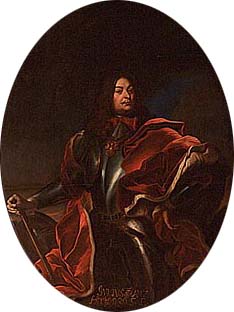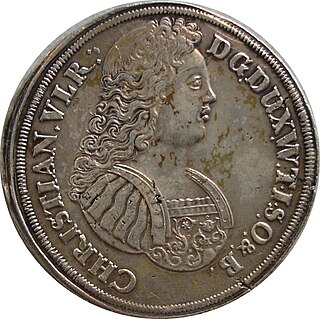
Amt Neuhaus is a municipality in the District of Lüneburg, in Lower Saxony, Germany. Amt means "municipal office" in German. The original "municipal office of Neuhaus" existed since at least the 17th century until 1885, consecutively as part of Saxe-Lauenburg, Electorate of Hanover (1689-1810), Kingdom of Hanover (1814-1866), and the Prussian Province of Hanover (1866-1885).

Alexander, Duke of Schleswig-Holstein-Sonderburg, was a Danish nobleman.

John the Younger or John of Denmark was the Duke of Schleswig-Holstein-Sonderburg.

The Duchy of Saxe-Lauenburg, was a reichsfrei duchy that existed 1296–1803 and 1814–1876 in the extreme southeast region of what is now Schleswig-Holstein. Its territorial center was in the modern district of Herzogtum Lauenburg and originally its eponymous capital was Lauenburg upon Elbe, though in 1619 the capital moved to Ratzeburg.

Ernest Günther of Schleswig-Holstein-Sonderburg-Augustenburg was a Duke of Schleswig-Holstein of its Sonderborg line. He was the first to have his ducal seat in Augustenborg Palace, which he built and named in honor of his wife. He ruled from 1647 until his death in 1689.

Maurice of Saxe-Zeitz was a duke of Saxe-Zeitz and member of the House of Wettin.

Schleswig-Holstein-Sonderburg was the name of a branch line of the House of Oldenburg as well as the name of their land. It existed from 1564 until 1668 and was a titular duchy under the King of Denmark, rather than a true territorial dukedom in its own right. The seat of the duke was Sønderborg. Parts of the domain were located in Denmark, mainly on the islands of Als and Ærø and around Glücksburg, whilst other lands were part of the Holy Roman Empire, including the Ämter of Plön, Ahrensbök, and Reinfeld. As a result of various inheritance arrangements it fragmented into numerous small territories which were eventually absorbed into Greater Denmark in the 18th century.

Francis II of Saxe-Lauenburg, was the third son of Francis I of Saxe-Lauenburg and Sybille of Saxe-Freiberg, daughter of Duke Henry IV the Pious of Saxony. From 1581 on he ruled Saxe-Lauenburg as duke.

Julius Francis was duke of Saxe-Lauenburg between 1666 and 1689. He was a son of Duke Julius Henry and his third wife Anna Magdalena of Lobkowicz, daughter of Baron William the Younger Popel of Lobkowicz. He was officially known as Julius Franz von Sachsen, Engern und Westfalen.

Frederick Charles of Schleswig-Holstein-Sonderburg-Plön, known as Friedrich Karl or Friedrik Carl of Holstein-Plön, was a member of a cadet branch of the Danish royal family and the last duke of the Duchy of Schleswig-Holstein-Sonderburg-Plön, a Danish royal prince, and a knight of the Order of the Elephant. When he died without a male heir born of his marriage to Countess Christine Armgard von Reventlow, rule of the Duchy of Holstein-Plön returned to the Danish crown.
Eleonore Charlotte of Saxe-Lauenburg-Franzhagen was a duchess of Saxe-Lauenburg by birth and, by marriage, Duchess of Schleswig-Holstein-Sonderburg-Franzhagen, whose line and territorial legacy she co-founded.
Philip of Schleswig-Holstein-Glücksburg was the first Duke of Schleswig-Holstein-Glücksburg after the death of his father in 1622. He was the son of John II, Duke of Schleswig-Holstein-Sonderburg and Duchess Elisabeth of Brunswick-Grubenhagen.
The Franzhagen Castle - also known as Franzgarten or Franzhof was a castle near the present-day Schulendorf in southern Schleswig-Holstein. Before its destruction in 1716 it was owned by the dukes of Schleswig-Holstein-Sonderburg.
Francis Henry of Saxe-Lauenburg was a Prince of Saxe-Lauenburg

Eleonore of Anhalt-Zerbst was a member of the House of Ascania and a princess of Anhalt-Zerbst by birth and by marriage Duchess of Schleswig-Holstein-Sonderburg-Norburg.

Maria of Brunswick-Wolfenbüttel was a princess of Brunswick-Wolfenbüttel by birth and by marriage Duchess of Saxe-Lauenburg.

Duke Christian Ulrich I of Württemberg-Oels was a German nobleman. He was the ruling Duke of Württemberg-Bernstadt from 1669 to 1697 and then the ruling Duke of Oels-Württemberg from 1697 until his death.

Princess Christiana of Schleswig-Holstein-Sonderburg-Glücksburg, often referred to as Christiane was the consort of Christian I, Duke of Saxe-Merseburg, who was the ruling Duke of Saxe-Merseburg from 1650 until his death.
Louis Charles, Duke of Schleswig-Holstein-Sonderburg-Franzhagen was a German nobleman and ruler from the House of Schleswig-Holstein-Sonderburg, cadet line of the House of Oldenburg.
Christian Adolf I, Duke of Schleswig-Holstein-Sonderburg-Franzhagen was a German nobleman and Duke of Schleswig-Holstein-Sonderburg-Franzhagen.












